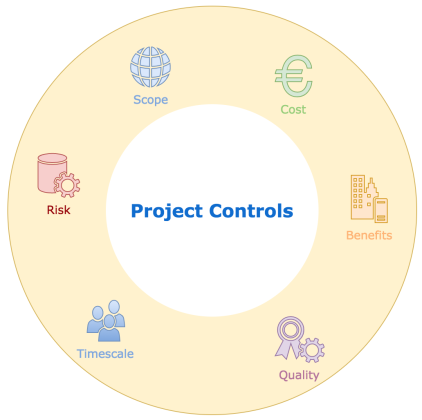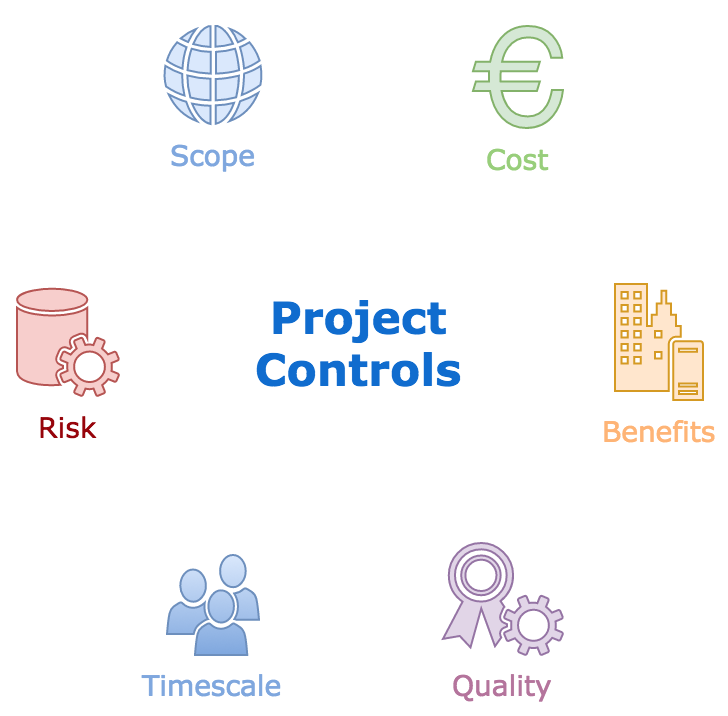
The Importance of Project Controls
The Importance of Project Controls
In something like a PRINCE2 project, there are 6 aspects of project performance to be managed. Each aspect requires some form of control, these controls feed in to reports and updates to your stakeholders as part of a managed communication strategy.
- Risk
- Benefits (or dis-benefits)
- Timescale
- Scope
- Quality
- Cost

Risk
There is Risk in all projects, a project is by its very nature, something ‘different’ and anytime you do something differently you have some element of the unknown, this unknown is the source of all Risks.
Project Controls is about defining the acceptable level(s) of Risk you can accept at various stages of the project. If we accept the Risk is there anything we can do to mitigate the likelihood of the Risk?
Benefits
This should be the underlying reason or reasons for the project, yet this is often the most overlooked aspect. At every stage, and especially during the early initiation activities we should be reminded to ask ourselves ‘Why are we doing this?’
If your project is to build widgets for 2% less than the current build cost, yet it’s going to take 4 years of engineering and take you 10 years to recoup the costs based on the current sales and sales-cost numbers, or you can go away and license a patented design from another engineering house that will deliver savings of 1.9% and show a return on investment in 3 years, you probably shouldn’t be doing this project.
Being able to define the ultimate deliverable and how that deliverable can help you is key to the success of any project.
Timescale
This is one of the most important parts of Project Management and this all comes down to Planning, in fact this is what most people would say is the key purpose of Project Management.
When will it be finished?
Scope
Scope and more specifically Scope Creep is the main reason that projects fail. Exactly what will the project deliver?
Without knowing what the final deliverable is, you can’t ask the question about expected benefits and without knowing those, you can’t be sure that the project is good value.
However, the end deliverable is not the only thing we need to care about, we need to be sure that we don’t take too many diversions along the way.

Let’s say our project is to build a new iPhone App. We define the deliverable, we define the benefits, costs, timescale and the risks. We have a Project Plan. Then as we start to undertake the work, the design team decide that it would be good give the website a facelift to match the design of the new application, this user interface work will coincide with long held plans to update the icons used in product documentation and marketing materials.
All of these additional work-streams will add some value to the business but the front-end of our new app has just been pushed to bottom of the queue by the design team in order for them to create all these new icons, a new website and finally the new applications user interface. If the reason for doing this is to get there first which is often the case in the technology sector, we’ve just taken on a huge amount of risk in the timescale area.
Scope and especially Scope Creep are areas that need to be most tightly controlled, especially in traditional Project Management.
Quality
An end product should be Fit for Purpose (Quality). Delivering a project on time and on budget are marks of success, but if that deliverable is a pile of junk, then was it worth it? Probably not!
Quality as with all Project Controls should be defined, monitored and reported upon.
Sometimes Quality can be measured, for example a new widget will have X features with less than 0.003% variance to ensure consistency.
Cost
The project has to be affordable! If we again consider our little widget company and their project to build new widgets. If these new widgets come at a cost of £1m yet the maximum credit available to the company is only £300k, we simply can’t afford it.
Costs include the development costs, the staffing, materials, specialist services etc.
As a project develops, it is not uncommon for a project cost to increase, and rarer, but still not uncommon, a project cost can decrease also.
Understanding what the baseline is, the measure points and having a good communication strategy for keeping your stakeholders up-to-date are all key to the Cost element of Project Controls.
Happy Valentines day 😍
